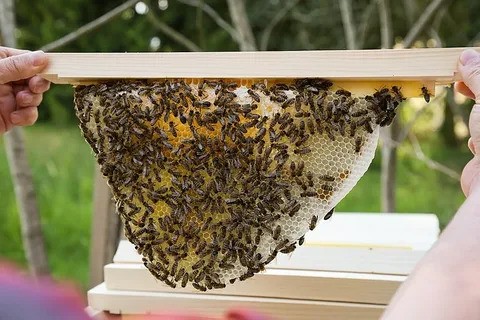Controlling Varroa mites is crucial for maintaining the health and productivity of your beehive. Oxalic acid vaporization is one of the most effective methods for managing these pests. In this comprehensive guide, we’ll cover everything you need to know about oxalic acid vaporization, from preparation to post-treatment care, ensuring your bees stay healthy and thriving. Remember, wearing proper beekeeping suits and Beekeeping Jackets is essential to protect yourself during the vaporization process.
Understanding Oxalic Acid Vaporization
What is Oxalic Acid Vaporization?
Oxalic acid vaporization involves heating oxalic acid until it turns into vapor, which is then introduced into the hive. This vapor disperses throughout the hive, killing Varroa mites on contact. This method is preferred by many beekeepers due to its high efficacy and minimal impact on the bees.
How Oxalic Acid Works Against Varroa Mites
Oxalic acid is a naturally occurring compound that, when vaporized, attaches to the bodies of Varroa mites. This causes dehydration and eventually death for the mites, effectively reducing their population without harming the bees.
Benefits of Using Oxalic Acid Vaporization for Beekeeping
Using oxalic acid vaporization offers several benefits:
- Highly effective against Varroa mites
- Minimal impact on bees and hive activity
- Cost-effective and easy to perform
- Compatible with other Varroa mite control methods
Preparing for Oxalic Acid Vaporization
Essential Beekeeping Gear for Safety
Safety is paramount when performing oxalic acid vaporization. Ensure you have the following beekeeping gear:
- Protective gloves
- Safety goggles
- Respirator mask
- Full beekeeping suits to protect from potential exposure
Selecting the Right Time for Treatment
The best time for oxalic acid vaporization is during periods of low brood activity, typically in late fall or early winter. This timing ensures the maximum number of mites are exposed to the treatment.
Preparing the Oxalic Acid and Vaporizer
Follow these steps to prepare:
- Measure the Oxalic Acid: Use the appropriate amount of oxalic acid dihydrate, as specified by the manufacturer.
- Set Up the Vaporizer: Assemble and preheat the vaporizer according to the manufacturer’s instructions.
Step-by-Step Guide to Oxalic Acid Vaporization
Detailed Instructions for Performing Oxalic Acid Vaporization
- Set Up the Vaporizer:
- Load the measured oxalic acid into the vaporizer.
- Preheat the vaporizer to the required temperature.
- Administering the Treatment:
- Insert the vaporizer into the hive entrance or through a pre-drilled hole.
- Activate the vaporizer, allowing the oxalic acid to vaporize and spread throughout the hive.
- Monitoring Hive Conditions:
- Observe the hive to ensure the vapor is dispersing properly.
- After treatment, remove the vaporizer and seal the hive entrance.
Safety Considerations
Importance of Wearing Proper Beekeeping Suits
Always wear full beekeeping suits along with gloves, goggles, and a respirator mask to protect yourself from the oxalic acid vapor. This gear is essential to prevent exposure and ensure your safety during the process.
Handling and Storage of Oxalic Acid
Store oxalic acid in a cool, dry place, away from children and pets. Handle it with care, and always follow the manufacturer’s safety instructions to avoid accidents.
Safety Tips for Using a Vaporizer
- Use the vaporizer in a well-ventilated area.
- Follow the manufacturer’s guidelines for operation and maintenance.
- Keep a fire extinguisher nearby as a precaution.
Post-Treatment Care and Monitoring
Checking the Effectiveness of the Treatment
After treatment, monitor your hive to assess the effectiveness of the oxalic acid vaporization. Look for a decrease in mite population and an improvement in bee activity.
Recording Data and Observations
Keep detailed records of the treatment, including the date, time, and observed effects. This information is valuable for tracking the health of your hive over time.
Follow-Up Treatments and Additional Varroa Mite Control Methods
Depending on the severity of the infestation, follow-up treatments may be necessary. Integrate other Varroa mite control methods, such as drone brood removal and screened bottom boards, for comprehensive management.
Common Questions and Troubleshooting
FAQs About Oxalic Acid Vaporization
- Is oxalic acid vaporization safe for bees?
- Yes, when used correctly, it is safe and does not harm the bees.
- How often should I treat my hives with oxalic acid vaporization?
- Treatment frequency depends on mite levels and seasonal considerations, but generally 2-3 treatments per year are recommended.
Troubleshooting Common Issues
- Inconsistent Vaporization: Ensure the vaporizer is functioning correctly and follow the manufacturer’s guidelines.
- Bee Reactions: Some bees may exhibit temporary increased activity or agitation post-treatment, which typically subsides.
Expert Tips for Successful Treatment
- Use the correct amount of oxalic acid to avoid under or over-treating.
- Perform treatments during optimal weather conditions to enhance effectiveness.
Conclusion
Oxalic acid vaporization is a powerful and effective tool in the fight against Varroa mites, crucial for maintaining the health and productivity of your beehive. By following the steps and best practices outlined in this guide, you can effectively manage mite populations and support your bees’ well-being. Regular monitoring, proper hive management, and using the right beekeeping gear are key to achieving the best results and ensuring a thriving beekeeping operation.
